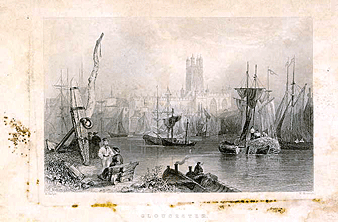A print with an evenly mellowed surface, though
duller than it was originally, is still collectible. Any attempts you
make to brighten its colors will be useless and will add nothing to its
value.
Fasten valuable prints to cardboard by using
hinges, similar to those used in mounting stamps. On large prints, three
or four hinges, made of any kind of gummed cloth tape, may be necessary
while on smaller ones, two or three will do. Itís better to use a glue
that wonít stick too tight and tear the print should you need to
remove them. Hinges for larger prints should be two or more inches wide
while those for smaller ones should be one inch or more wide. Make the
outside ones flush with the edges of the print. This prevents corners
from tearing. Of course, youíll need to fasten the hinges to the back
of prints.
Be sure the cardboard on which you mount the
print is two inches or more larger in each dimension than the print,
itself. Itís also good idea to cover the print with a piece of
cellophane. Glue it to the cardboard all around its edges. This allows
the print to be seen and handled without danger of injury and keeps out
dust and air.
 With some ingenuity, youíll find ways to
store your prints. There are some print cabinets that have drop fronts
in which prints can be stored in an upright position. If you chose to
store your prints in such a cabinet, youíll have to mount them as
above. You can often find old wooden boxes at flea markets or auctions.
However, plastic milk containers, designed to hold file folders, are
ideal for small prints.
With some ingenuity, youíll find ways to
store your prints. There are some print cabinets that have drop fronts
in which prints can be stored in an upright position. If you chose to
store your prints in such a cabinet, youíll have to mount them as
above. You can often find old wooden boxes at flea markets or auctions.
However, plastic milk containers, designed to hold file folders, are
ideal for small prints.
You can easily remove surface dust and grime
from your prints easily by using a kneaded eraser. Keep your strokes
light and exercise care so that you donít remove any of the
descriptive lettering or coloring. You can whiten a dirty margin by
rubbing lightly with powdered pumice, but donít do this to any part of
the print except the blank margins.
 Aside from these suggestions, thereís little
that you can do to correct damages that have occurred through the years.
However, there is much that can be done to prevent further
deterioration. Stains and foxing, if not too pronounced, can sometimes
be removed or rendered less prominent by careful use of a bleaching
compound. Do such "washing" very cautiously, for you can
damage colors and even rot the paper. Ordinary laundry bleach will do
this cleaning, but you should dilute it well. Never attempt to clean a
valuable print. Instead, take it to a professional conservator for
proper cleaning and repair.
Aside from these suggestions, thereís little
that you can do to correct damages that have occurred through the years.
However, there is much that can be done to prevent further
deterioration. Stains and foxing, if not too pronounced, can sometimes
be removed or rendered less prominent by careful use of a bleaching
compound. Do such "washing" very cautiously, for you can
damage colors and even rot the paper. Ordinary laundry bleach will do
this cleaning, but you should dilute it well. Never attempt to clean a
valuable print. Instead, take it to a professional conservator for
proper cleaning and repair.
You can repair slight tears on the margins of
prints by backing them with other paper. For this, use photographic
mounting tissue and cut the patches as small as possible. Do not use any
water-soluble glue, as it wrinkles the paper when it dries.
With a print on which the margins have been
trimmed for framing or other reason, the only thing you can do is to
have a picture framer matt it carefully. If the margins have been only
partially removed and the title is still attached, the print will
already have lost some of its value.
If you plan to display your prints on the wall,
theyíll require a different mounting than those kept in file cabinets.
Most of the damage to prints occurs as a result of improper framing,
which allows dust and air to reach the print. If youíre planning to
hand valuable prints, make it as nearly dust-proof and air-tight as
possible by making an air-tight unit of glass, print and backboard.
